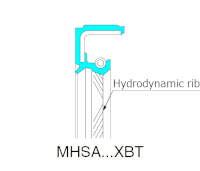Concentricity
Most conventional oil seals are designed only to withstand very low-pressure applications (about 8 psi or less). If additional internal pressure is present or anticipated, pressure relief is necessary.
The perfect remedy for this is to use oil seal materials that are rated for the temperature of your application. Also, ensure that the elastomer is free from volatile constituents like waxes, plasticizers, etc.
One of the main principles of power transmission is consistent lubrication. Shaft seals play a hugely important role in this. Imagine a situation involving a shaft-mount reducer – electric motor prime mover, driven by belts, motion controlled by a torque arm – with an improperly seated seal. A blown-out input shaft seal is a nightmare situation, necessitating an entire breakdown and reassembly, not to mention re-aligning and re-tensioning the belts.

Out-gassing
1. The oil seal consists of a metal ring as the inner skeleton which provides the structural stability to the oil seal.

